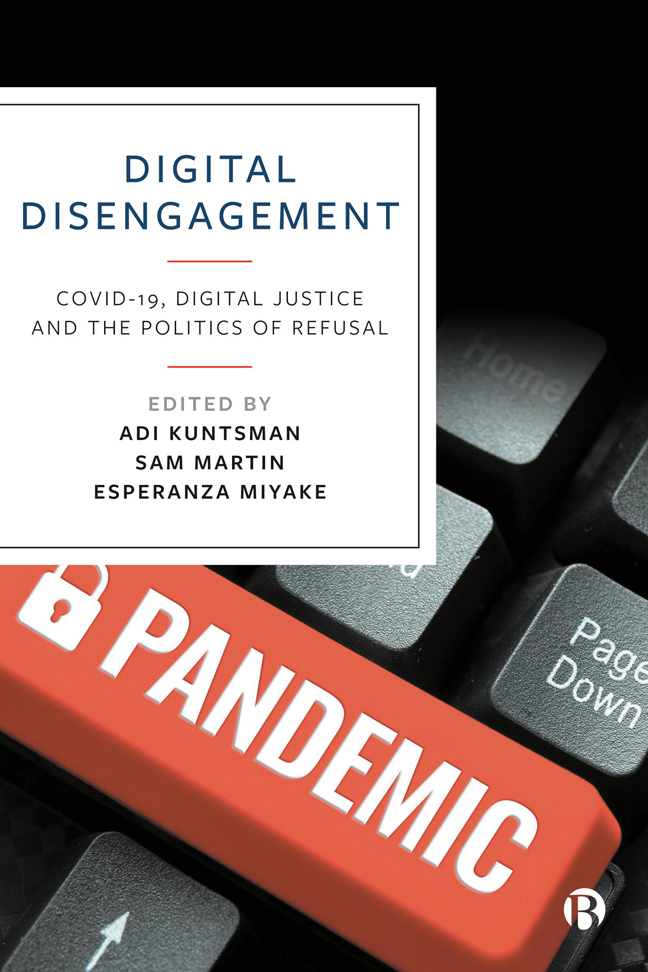Book contents
- Frontmatter
- Contents
- Notes on Contributors
- Introduction
- One En/forcing the Tokyo 2020 Olympics: The Racialization of Digital Engagement and Digital Solutionism
- Two Digital Engagements and Work–Life Balance in Creative Labour
- Three ‘#RoeVsWadeOverturned: Any Idea How Fast Your #PeriodtrackingApp Can Lead To Jail?’: Digital Disengagement and the Repeal of Roe vs Wade
- Four #SnailMailRevolution: The Networked Aesthetics of Pandemic Letter-Writing Campaigns
- Five Data Minimalism and Digital Disengagement in COVID-19 Hacktivism
- Six Digital Solutionism Meets Pandemic Imaginaries
- Seven State Violence, Digital Harms and the COVID-19 Pandemic: Imagining Refusal, Resistance and Community Self-Defence
- Epilogue: Digital Disengagement – Questions of Pandemic and Post-Pandemic Digitalities
- Index
One - En/forcing the Tokyo 2020 Olympics: The Racialization of Digital Engagement and Digital Solutionism
Published online by Cambridge University Press: 25 January 2024
- Frontmatter
- Contents
- Notes on Contributors
- Introduction
- One En/forcing the Tokyo 2020 Olympics: The Racialization of Digital Engagement and Digital Solutionism
- Two Digital Engagements and Work–Life Balance in Creative Labour
- Three ‘#RoeVsWadeOverturned: Any Idea How Fast Your #PeriodtrackingApp Can Lead To Jail?’: Digital Disengagement and the Repeal of Roe vs Wade
- Four #SnailMailRevolution: The Networked Aesthetics of Pandemic Letter-Writing Campaigns
- Five Data Minimalism and Digital Disengagement in COVID-19 Hacktivism
- Six Digital Solutionism Meets Pandemic Imaginaries
- Seven State Violence, Digital Harms and the COVID-19 Pandemic: Imagining Refusal, Resistance and Community Self-Defence
- Epilogue: Digital Disengagement – Questions of Pandemic and Post-Pandemic Digitalities
- Index
Summary
Introduction
On 24 March 2020, the International Olympic Committee (IOC) announced that both its president, Thomas Bach, and the Japanese Prime Minister at that time, Shinzo Abe, had reached an agreement to postpone the Tokyo 2020 Olympics by a year, in response to the COVID-19 pandemic crisis. The statement presented the decision as one made between the IOC and Japan, for the ‘good’ of the people, stating that ‘Human lives take precedence’ and ‘We agreed that the safety, security of the athletes and spectators are paramount’ (International Olympic Committee, 2020). A year later, with COVID-19 cases rising in Japan (which had to declare a state of emergency weeks before the Olympics), despite calls from the medical community and the majority of the population to cancel, the Olympics nonetheless went ahead. Athletes competed in audience-free stadias, and the promised boom for the tourism industry and the Japanese economy never occurred. Furthermore, there was little to no option for Japan to refuse: Japan was legally and contractually obliged to make the Olympics happen, or else they faced great financial loss/heavy fines. Global broadcasters, corporate sponsors and spectators around the world, watching from the comfort of their screens, had everything to gain. Japan was still burdened with the reality of having to deliver the Olympics for global consumption, despite the great associated financial losses and risks to the health and wellbeing of its citizens in the middle of a global pandemic.
The only way in which the Tokyo 2020 Olympics was able to happen at all was largely due to Japan's digital infrastructure. The Tokyo 2020 Olympics represents some of the most alarming – and as we will see, problematically racialized – ways in which the digital was offered as a perfect ‘solution’ to the ‘problem’ of hosting a global event during the pandemic. In his work on technological solutionism, Morosov (2013) discusses the propensity for solutionists to recast complex social situations through quick technological ‘fixes’, arguing that such ‘solutions’ lead to ‘unexpected consequences that could eventually cause more damage than the problems they seek to address’ (Morosov, 2013: p 5).
- Type
- Chapter
- Information
- Digital DisengagementCOVID-19, Digital Justice and the Politics of Refusal, pp. 17 - 37Publisher: Bristol University PressPrint publication year: 2023

